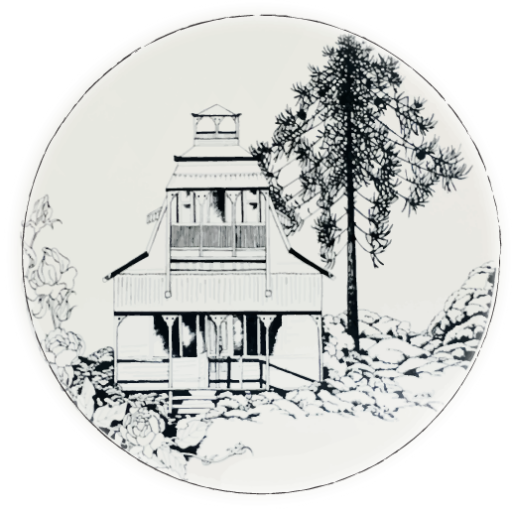A MONTVILLE FARMER, BUILDER, FIREMAN AND COMMUNITY WORKER

Farmer
Des arrived in Montville 70 years ago, in 1953 as a fresh-faced fourteen-year-old. His parents had bought a pineapple farm on the southern side of Western Avenue, and later rented a second farm on the northern side of the road. Des worked as a farm labourer chipping ‘pines’ for £1 ($2) a day to help support the family. In 1962, Des’s parents moved to Sandgate, selling the southern farm and Des took over the rent of the northern farm. After batching for 18 months, he married Bev Duhs in 1964. The first thing the newly-weds did was to take out a bank loan to buy the farm.
Builder
The farm income was so poor that Bev was earning more working at Coles than Des could make farming so he went to work with his uncle building farm sheds, cow bales and pig sties out of concrete and concrete blocks. However, from 1970 on, he worked for a number of Sunshine Coast builders expanding his skill base and becoming a much sort after builder and tiler. With Bev working at Coles and Des working as a partner with builder, Arthur Walker, an after-hours farmer and night tiler, they were able to pay off their loan and start their family; Michelle then Michael.
Community Service
Both Des and Bev shared the values of living in a small community and contributing to its wellbeing. In the early 1970s, Des joined the new hall committee fighting to save the old School of Arts Hall infested with white ants and requiring urgent repairs. Des restumped the building, ran the front rod across the width of the ceiling to pull the sagging wall in, eradicated the white ants, repainted the hall inside (at night) and installed concrete steps at the main entrance mainly voluntary, after-hours work led by Des restored the hall as a community facility for another fifty years.
Although the restoration of the hall was the biggest community project Des was involved in, it wasn’t the only one. He helped build and stand the Bell Tower at the St. Mary’s Church of England Church. He helped stand a new flag pole in the Village Green. And with Bev, he helped in setting up the Easter Dawn Service in Carpenter’s Place, Carols by Candlelight on the Village Green, the ANZAC Day Dawn Service at the World War One Memorial in front of the hall and was a willing supporter of School P&C Working Bees. His donation to many a school fete consisted of a truckload of pineapples for the local fruit stall. Not a committee man, Des however agreed to become a Trustee of the Montville Sports and Recreation Grounds in the 1980s until 1992 when it was transferred to the MVA. With his truck, his tools and his experience, Des was always the first to be approached to help another community project.
Des was also a well-regarded member of the Montville Rural Fire Brigade. Des was elected First Officer of the Brigade in 1984, and stayed in that role for 10 years. During this time, Des and Len Gorsch had 4×4 tractors with 500 litres spray units with hose reels for their orchards which they adapted for fire-fighting purposes when needed. Under Des’s leadership, the brigade acquired its first official fire truck in 1986 and soon after a 5000- litre back-up tank on a trailer.
Des and Bev loved their dancing and over a number of years organised dances to raise much needed funds towards the extensions for the Montville Hall, including change rooms, toilets, store rooms and kitchen.
Montville Citizen of the Year Award
In 1999, Des and Bev were jointly presented with the Montville Citizen of the Year Award for their service to the community over four decades. They relocated to and spent the next 23 years creating a very successful avocado farm, leasing their much smaller Montville farm – their family home. After Blackbutt, they retired to a ¾-acre block behind the Glasshouse Mountain Sporting Precinct where Des could still have his vegetable garden and fruit trees.
Over the last couple of years, Des and Bev have worked closely with the Montville History Group to record Montville’s history over the second half of last century – still quietly serving the community they claimed 60 years ago.
Doug Patterson
Montville History Group
November, 2023

 ©2016 Montville History Group. All rights reserved.
©2016 Montville History Group. All rights reserved.